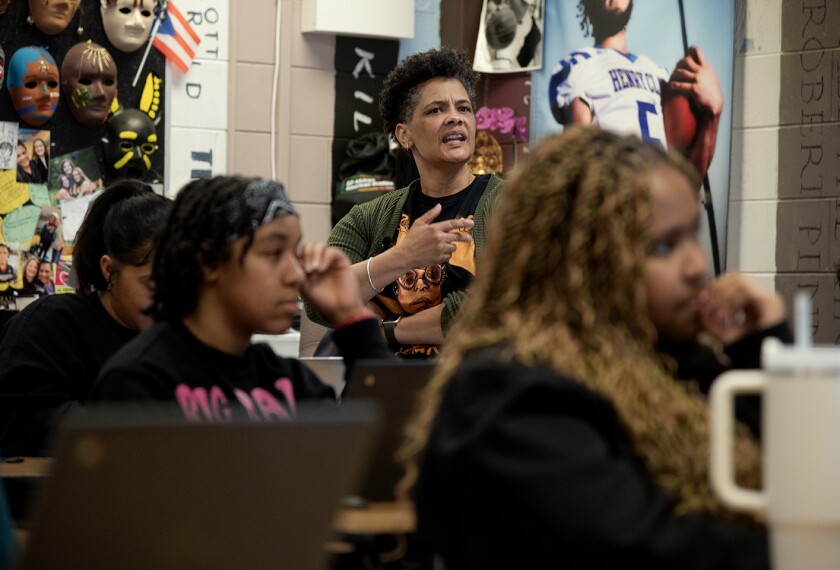Millions of U.S. students use Pearson’s curriculum products in their classrooms, but soon those print and digital resources will no longer fall under the education publishing giant’s business umbrella.
The London-based company announced recently it will sell off its K-12 U.S. print and digital curriculum business to focus on assessments and virtual schools, leaving educators wondering what that means for day-to-day instruction. Pearson officials said in a press briefing Feb. 23 that the company was already talking with potential buyers.
U.S. curriculum products and services were not big moneymakers among Pearson’s portfolio. Company officials called them a “lower margin” part of the global enterprise, representing 9 percent of the company’s revenues but returning profits of about 2 percent last year. Pearson generated 61 percent of its U.S. sales in prekindergarten through 12th grade and higher education.
Pearson’s reputation has taken some hits in recent years, as the company has become embroiled in a series of scandals and lawsuits and has been the target of complaints from educators and parents. This sale may add to the company’s public relations woes, said Alan Singer, a professor of teaching, learning and technology at Hofstra University who has studied the company.
“Whoever Pearson spins (its curriculum business) off to will service these things,” Singer said. “But Pearson has made promises to districts. It’s sold products and now it’s going to abandon them.”
Pearson remains committed to the U.S. K-12 market and will do everything it can to make the transition “seamless,” company officials pointed out. “We’re increasing our investment in virtual schools, building on our leading position in U.S. school and clinical assessment, and powering online learning,” Scott Overland, a Pearson spokesman, wrote in an email.
Educators React
Pearson’s K-12 curriculum business, which is called Pearson Learning Services, offers thousands of titles across dozens of programs in math, literacy, science, social studies, world languages, music, and intervention. The sale will also include the professional development services that wrap around curriculum, Overland said.
Pearson reported a percentage revenue decline in the “high single digits” last year in U.S. sales of curriculum products.
It didn’t help that the company was at the center of failed efforts by the Los Angeles school system to implement a massive 1-to-1 computing initiative using iPads pre-loaded with Pearson content, which the district said was incomplete. In 2015, Pearson settled a lawsuit with the district for $6.45 million. A year earlier, Pearson’s nonprofit arm, the Pearson Charitable Foundation, was forced to close and pay $7.7 million in fines after it broke New York state law by helping its for-profit parent develop Common Core-aligned education products.
But some educators believe the upcoming sale could have positive results on the ground.
William R. Shields, the superintendent of the 3,800-student Community Consolidated School District 93 in Bloomington, Ill., said that over the years his district has been shedding Pearson curriculum products because of poor customer service.
Currently, the K-8 district is only using Pearson’s literacy curriculum, Reading Street. Shields said that frequent turnover among Pearson representatives resulted in a lack of attention to district needs, prompting him to call Pearson headquarters to complain.
Pearson “was just getting so big they lost touch,” he said. “It depends on who they sell it to, but it may end up being an advantage to us.”
Daniel A. Domenech, the executive director of AASA, The School Superintendents Association, said the move by Pearson appears to be part of an overall trend of pulling back and refocusing. In 2015, for example, Pearson sold its popular learning management system PowerSchool to Vista Equity Partners.
“Slowly but surely, all of the giants of the textbook industry are disappearing,” Domenech said. “Teachers are becoming more adept at providing instruction and making use of the material that is freely available on the internet.”
Digital Assessments Grow
Pearson is jettisoning its print and digital curriculum business in part to focus more on its $1.2 billion U.S. assessment business—which grew 7 percent in the number of digital tests administered last year—and its virtual school portfolio. Pearson’s assessment sales in the United States and the United Kingdom account for about 16 percent of the company’s revenues, according to John Fallon, the chief executive of Pearson.
“We’ve continued to invest and we’re well-positioned now to grow again in these markets as they stabilize,” Fallon said in the discussion of its 2017 financial results.
Pearson delivered 25.3 million standardized online tests to K-12 students. Conversely, Pearson’s paper-based standardized testing fell 7 percent to 20.4 million. Fallon said Pearson is still the largest testing vendor in the United States, and has spearheaded a shift toward digital testing with TestNav, its digital platform. More than half of the total tests administered are now digital, he said, and Pearson’s leadership role in developing digital tests “is allowing us to develop strong partnerships, and through those partnerships reduce our own regulatory risk.”
But Pearson has also faced controversy in this sector and is currently embroiled in an ongoing dispute of Iowa’s award of a $31 million state testing contract to the American Institutes of Research.
In addition, Fallon said, two of the biggest growth areas for Pearson are in partnering with charter boards to run virtual schools, and partnering with universities to provide fully online degrees. “Both markets are relatively earlier in their development,” he said. Pearson owns Connections Education, a virtual school provider.
In the United States, virtual schools represent a $1.5 billion market across 34 states. Connections Education is the country’s second-largest virtual education provider, behind K12 Inc. Last year, Connections experienced 6 percent growth in full-time-equivalent student enrollment.





